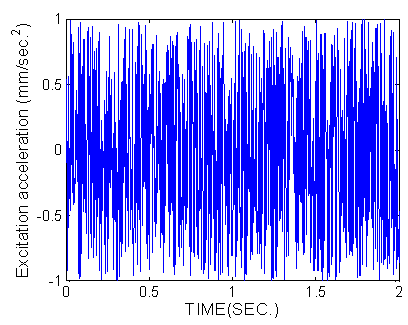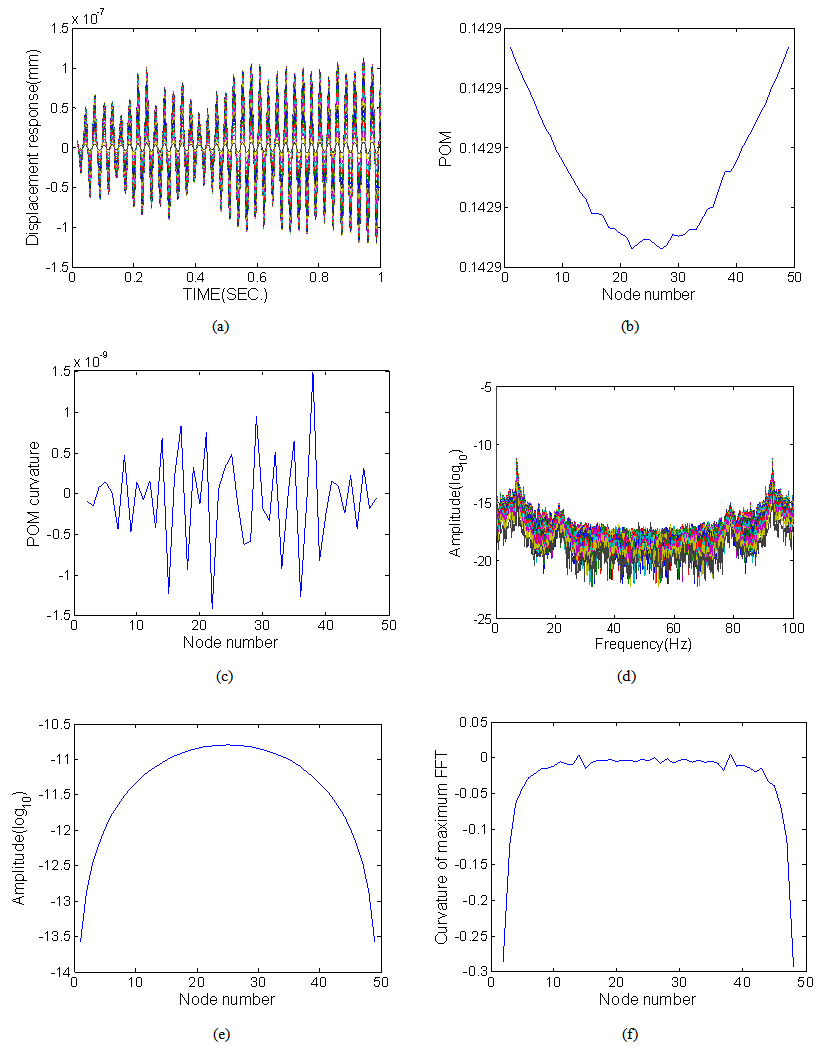-
Paper Information
- Next Paper
- Paper Submission
-
Journal Information
- About This Journal
- Editorial Board
- Current Issue
- Archive
- Author Guidelines
- Contact Us
Journal of Civil Engineering Research
p-ISSN: 2163-2316 e-ISSN: 2163-2340
2015; 5(5): 114-117
doi:10.5923/j.jce.20150505.03
Damage Detection of Beam Structure Using the Transformation of Measurement Data
Hee-Chang Eun1, Dong-Ho Cho1, Chang-Young Chung2
1Department of Architectural Engineering, Kangwon National University, Chuncheon, Korea
2Department of Architecture, Hallym Polytechnic University, Chuncheon, Korea
Correspondence to: Hee-Chang Eun, Department of Architectural Engineering, Kangwon National University, Chuncheon, Korea.
| Email: |  |
Copyright © 2015 Scientific & Academic Publishing. All Rights Reserved.
Structural damage should be evaluated based on measurement data in the frequency and time domain. The applicability of most damage detection methods is deeply related to the noise contained in the measurement data. In this study, the damage detection methods derived from the displacement responses in the time domain is proposed and they are compared in a numerical experiment.
Keywords: Damage detection, Frequency response function, Noise, Curvature
Cite this paper: Hee-Chang Eun, Dong-Ho Cho, Chang-Young Chung, Damage Detection of Beam Structure Using the Transformation of Measurement Data, Journal of Civil Engineering Research, Vol. 5 No. 5, 2015, pp. 114-117. doi: 10.5923/j.jce.20150505.03.
Article Outline
1. Introduction
- Early detection of defects in civil structures is a critical process in assisting structural maintenance and management plans. With a robust damage detection methodology, it becomes possible to fix the structure during the early stages of damage, therefore, avoiding any future unanticipated accidents that may result in physical, economical, and psychological effects on the society.Frequency domain methods rely on analytical models but time domain methods are independent of modal parameters and analytical models. Zang et al. [1] presented a structural damage detection method combining independent component analysis extraction of time domain data and artificial neural network to reduce measurement noise. Lu and Gao [2] proposed a time-series model for structural damage considering a damage sensitive feature and unknown input excitation. Nguyen et al. [3] presented some applications of a principal component analysis from output-only measurements in the time and frequency domain for damage detection. Most damage detection methods are performed utilizing the data in the frequency and time domain. The accuracy of the damage detection methods depends on the sensitivity to external noise. Thus, it is practical to import the damage detection method to diminish the noise effect. This study starts with the displacement responses measured or simulated in the time domain. The data transformed to the ones in the frequency and time domain. The estimated curvature using the transformed data is utilized as the damage index. The applicability of the proposed methods is investigated and compared through a numerical experiment.
2. Time and Frequency Domain Approach for Damage Detection
- The dynamic response of a structure of n dofs in the time-domain which is assumed to be linear and subjected to random base excitation can be described by the equations of motion
 | (1) |
 and
and  denote the
denote the  analytical mass, damping, and stiffness matrices, respectively,
analytical mass, damping, and stiffness matrices, respectively,  , is a vector with all its elements equal to 1, and
, is a vector with all its elements equal to 1, and  is the unknown acceleration of base excitation. Dynamic responses of practical system are contaminated by external noise. In this study, the noise is simulated by adding a series of random numbers to the calculated displacement responses. The displacements
is the unknown acceleration of base excitation. Dynamic responses of practical system are contaminated by external noise. In this study, the noise is simulated by adding a series of random numbers to the calculated displacement responses. The displacements  for describing the practical responses at node j can be calculated from the simulated noise-free displacements,
for describing the practical responses at node j can be calculated from the simulated noise-free displacements,  by the following equation:
by the following equation: | (2) |
 denotes the relative magnitude of the error and
denotes the relative magnitude of the error and  is a random number variant in the range
is a random number variant in the range  The simulated displacements in the time domain contaminated by external noise should be utilized as basic data in detecting damage. However, the displacement responses do not provide accurate information on the damage and should be transformed to the data in the frequency and time domain. And the results are compared according to the applicability of the damage detection method. The displacements in the time domain are transformed to the ones in the frequency domain by taking fast Fourier transform (FFT). Taking the maximum values of absolute amplitude corresponding to the first resonance frequency at all nodes and estimating their curvature using a central difference method, the damage is traced. As the other approach, the displacements within a certain range of the time domain are transformed to the proper orthogonal mode (POM). The proper orthogonal decomposition (POD) of a discrete field involves solving the eigenvalue problem. Let
The simulated displacements in the time domain contaminated by external noise should be utilized as basic data in detecting damage. However, the displacement responses do not provide accurate information on the damage and should be transformed to the data in the frequency and time domain. And the results are compared according to the applicability of the damage detection method. The displacements in the time domain are transformed to the ones in the frequency domain by taking fast Fourier transform (FFT). Taking the maximum values of absolute amplitude corresponding to the first resonance frequency at all nodes and estimating their curvature using a central difference method, the damage is traced. As the other approach, the displacements within a certain range of the time domain are transformed to the proper orthogonal mode (POM). The proper orthogonal decomposition (POD) of a discrete field involves solving the eigenvalue problem. Let  matrix
matrix  be defined as
be defined as | (3) |
 denotes the displacement response matrix in the time domain extracted to obtain the POMs,
denotes the displacement response matrix in the time domain extracted to obtain the POMs, 
 and s is the number of the displacement response data sets extracted after the first r frequency response function (FRF) data sets. Solving the eigenvalue problem of Eq. (5) at the core of the POD method, Eq. (5) satisfies
and s is the number of the displacement response data sets extracted after the first r frequency response function (FRF) data sets. Solving the eigenvalue problem of Eq. (5) at the core of the POD method, Eq. (5) satisfies | (4) |
 | (5) |
 are the proper orthogonal values (POVs) and each eigenvector
are the proper orthogonal values (POVs) and each eigenvector  of the extreme value problem is associated with a POV
of the extreme value problem is associated with a POV 
 represents the eigenvector corresponding to the largest eigenvalue
represents the eigenvector corresponding to the largest eigenvalue  The POMs may be used as a basis for the decomposition of
The POMs may be used as a basis for the decomposition of  The POM associated with the greatest POV is the optimal vector. If the eigenvalues are normalized to unit magnitude, they represent the relative energy captured by the corresponding POM. The eigenvalue reflects the relative kinetic energy associated with the corresponding mode. The energy is defined as the sum of the POVs. The POMs are written as
The POM associated with the greatest POV is the optimal vector. If the eigenvalues are normalized to unit magnitude, they represent the relative energy captured by the corresponding POM. The eigenvalue reflects the relative kinetic energy associated with the corresponding mode. The energy is defined as the sum of the POVs. The POMs are written as | (6) |
 | (7) |
 is numerically obtained by a central difference approximation:
is numerically obtained by a central difference approximation: | (8) |
 is the second derivatives at the jth node of the first POM and the h is the distance between two successive nodes. In the following, the validity of the proposed methods in the frequency and time domain is investigated is illustrated in a numerical experiment. And the applicability of the methods is compared based on the results of the tests.
is the second derivatives at the jth node of the first POM and the h is the distance between two successive nodes. In the following, the validity of the proposed methods in the frequency and time domain is investigated is illustrated in a numerical experiment. And the applicability of the methods is compared based on the results of the tests.3. Numerical Experiment
- A numerical experiment was performed in detecting damage of a finite element model of a fixed-end beam shown in Fig. 1 to examine the validity of the proposed method. The nodal points and the elements are numbered as shown in the figure. A beam with a length of 1 m is modeled using 50 beam elements. The beam has an elastic modulus of
 and a unit mass of
and a unit mass of  The beam’s gross cross section is
The beam’s gross cross section is  and its damage section is established as
and its damage section is established as  The damping matrix is assumed as a Rayleigh damping to be expressed by the stiffness matrix and a proportional constant of 0.0001. This application considers the damage detection of beam structure with multiple damages at elements 15 and 38.
The damping matrix is assumed as a Rayleigh damping to be expressed by the stiffness matrix and a proportional constant of 0.0001. This application considers the damage detection of beam structure with multiple damages at elements 15 and 38.  | Figure 1. A fixed-end beam structure model |
 shown in Fig. 2. The displacement responses in the time domain are calculated by solving the dynamic equation of the finite element model. The measured displacement responses including contaminated external noise are described by inserting
shown in Fig. 2. The displacement responses in the time domain are calculated by solving the dynamic equation of the finite element model. The measured displacement responses including contaminated external noise are described by inserting  in Eq. (2).
in Eq. (2). | Figure 2. Accelerations of external excitation at the left support |
 and
and  , the POM corresponding to the first POV and its curvature are obtained in Figs. 3(b) and (c), respectively. The damage is detected by the abrupt change in the POM curvature curve. It is shown that the damage locations do not correspond with the positions of the abrupt change. It indicates that the curves are sensitive to the external noise and do not provide the accurate clue of the damage.
, the POM corresponding to the first POV and its curvature are obtained in Figs. 3(b) and (c), respectively. The damage is detected by the abrupt change in the POM curvature curve. It is shown that the damage locations do not correspond with the positions of the abrupt change. It indicates that the curves are sensitive to the external noise and do not provide the accurate clue of the damage.4. Conclusions
- Most damage detection methods are affected by external noise. This work considered the damage detection to diminish the noise effect. performed utilizing the data in the frequency and time domain. Starting with the displacement responses in the time domain, the data are transformed to the ones in the frequency and time domain. Estimating the curvature of the transformed data, a damage detection method was presented and its validity and comparison were illustrated in a numerical experiment.
ACKNOWLEDGEMENTS
- This research is supported by Basic Science Research Program through the National Research Foundation of Korea (NRF) funded by the Ministry of Education (2013R1A1A2057431).
 Abstract
Abstract Reference
Reference Full-Text PDF
Full-Text PDF Full-text HTML
Full-text HTML